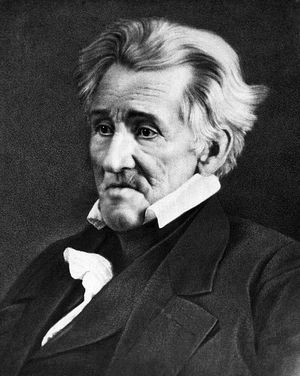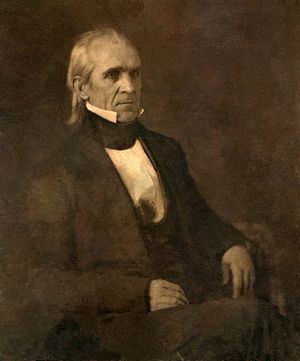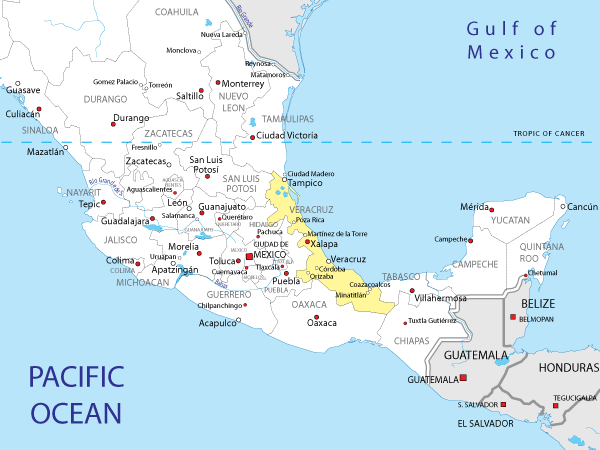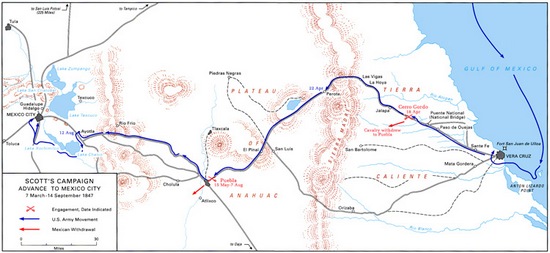Mexican American History
19th Century
The Mexican American War
1846-1848
Spain dominated Mexican institutions for over three hundred years. Every aspect of Mexican life, language, religion, culture and military were infused with Spanish influence in this Central American country. However, by 1811, the desire for freedom from European domination, like their American neighbors to the north, spurred an eleven year revolt that created a new, independent nation.
Although Mexico was a large country, its size was smaller than the
territories it acquired from Spain on the North American continent. This
rich inheritance, the spoils of war, clashed with the American's
appetite for expansion. The war with Spain was rapidly replaced by war
with the "yanquis". Freedom from Spain had not brought them peace.
Mexican American history began with the Texas War of Independence,
and then evolved in a direct confrontation with the United States over Texas
annexation. Mexico's recollection of these years will always be tempered
by the loss of an empire before it could enjoy its fruits. Its
relations with America in the 19th century shall always define Mexican
American History.
As early as the 1819 Treaty with Spain that drew the limits of American boundaries, and specifically excluded Texas, American settlers completely disregarded agreed lines to cross into the north eastern corner of Cuahuila-Texas. The vistas of unclaimed land attracted speculators and developers, who in turn, opened the spigot for land starved Americans. Stephen Austin, the reputed father of Texas, armed with a Spanish land grant, was ready to take commercial advantage of the land which he held. He sought friendly relations with Mexican authorities, and never desired or anticipated the battles ahead..
Mexican American History.
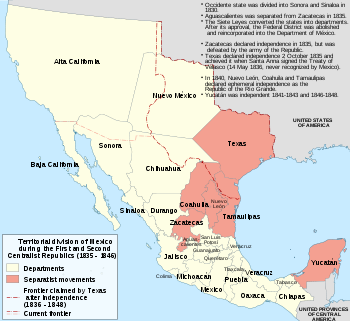
Mexican American History
Mexico and its Territories 1821-1830 minus northeast Texas
Some in the United States rejected the necessity for a new war. Whigs, traditionally the party of peace, were split and its majority sided with the opposition Democratic party led by an ardent expansionist, President James J. Polk (1845). The anti-slavery abolitionists, the backbone of the Whig Party, and dead set against the potential of Texas as another slave state, maintained slavery was the real rationale for the war with Mexico, and was against "God's will". Those in favor of war said that American expansion through Texas annexation was "God's will". Paradoxically, the Lord was strongly in favor of two sides of the same issue.
Congressman Abraham Lincoln speaking for the minority view on January 12, 1848: (prior to the end of the war)
" Mr. Chairman:
Some, if not all, of the gentlemen on the other side of the House, who have addressed the committee within the last two days, have spoken rather complainingly, if I have rightly understood them, of the vote given a week or ten days ago, declaring that the war with Mexico was unnecessarily and unconstitutionally commenced by the President. I admit that such a vote should not be given in mere party wantonness, and that the one given is justly censurable, if it have no other or better foundation. I am one of those who joined in that vote; and I did so under my best impression of the truth of the case----".
Mexican American History.
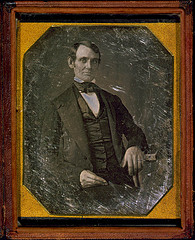
Congressman Lincoln
Photograph 1846
Library of Congress
Lincoln's antipathy for a war with Mexico was reflected in the domestic, political environment in the United States.The United States, maintained by its political institutions, had peaceful successions of seven administrations despite heated differences on Texas annexation and the Mexican war.
On the other hand, Mexico's internal reaction to war with Texians (1821-1846), and thereafter war with the United States (1846-1848), resulted in disruptive coups. Mexico could not find stable leadership that was the hall mark of American governments. First there was war with Spain, and immediately thereafter with the Americans. Forty-eight years without peace, and then in 1862 defending against a French invasion, inevitably meant a loss of personal freedom, poverty and non- responsive governing. Some would argue that this was a just cause for strained relations with a stronger northern neighbor that defined Mexican American history for a century.
Mexican American History.
President Dates Positions
John Quincy Adams 1825-29 anti annexation
Andrew Jackson 1829-37 pro annexation-no action
Martin Van Buren 1837-41 ignored any commitment
William Henry Harrison 1841- died in office
John Tyler (successor) 1841-45 sought annexation
James J. Polk 1845-49 declared war on Mexico
Zachery Taylor 1849-50 general led war effort (Whig)
Mexican American History.
|
Mexican American History.
Andrew Jackson James J. Polk John Quincy Adams |
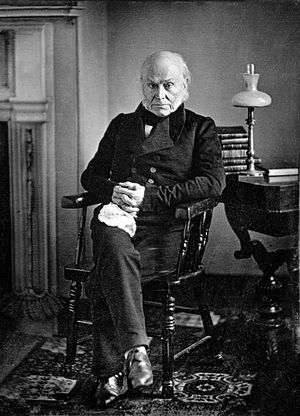 Mexican American History |
President Adams was dedicated to the anti slavery movement, and hence strongly opposed to incorporating another slave state. He was followed into office by his political enemy, Jackson, who was a cautious expansionist in office, but much more aggressive about that sentiment in his choice of successors. Van Buren overtly dodged the question of Texas annexation, but his non action played against the possibility of British commercial exploitation of Texas cotton, and their strong antipathy to slavery. Tyler, was universally disliked by all political persuasions, and sought to gain favor with Jacksonian Democrats by pursuing a treaty with Texas for its annexation. Although he enlisted the aid of the powerful John C. Calhoun, the treaty was defeated in a senate vote.
The ex President, Jackson, must have been seething on the sidelines. In the election of 1844, he brushed aside candidacies of the usual prior presidents and inserted himself as a king maker. He chose a former speaker of the House of Representatives, James J. Polk, an ardent believer in Manifest Destiny. Polk, the first "dark horse candidate" was matched against the well known Whig, Henry Clay. The nomination of Polk spread like a wild fire as the first announcement ever broadcast by telegraph.
Polk's tenure in office began with a senate boost for the Tyler Texas treaty which had finally been approved by that body on the eve of Tyler's departure from office. The Texas boundaries had been fixed in 1844; on the west, the Nueces River, and on the south, the Rio Grande River. "Fixed" in American minds, but far from approved by Mexicans.
Mexican American History. Mexican American History
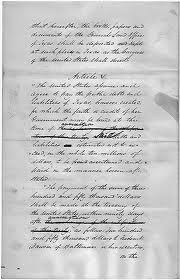 |
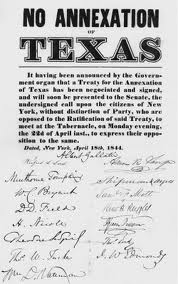 |
|
Mexican American History: |
Mexican American History:
|
President Polk's vision for the United States far exceeded the annexation of Texas. Early in his term of office, he extended an offer to Mexico of 30 million dollars to purchase New Mexico and California-----essentially 50% of Mexican territory in North America. The total territories formed a large part of Mexico's claim between 600,000 to one million square miles including 268,000 square miles in Texas. The areas included territories like New Mexico, heavily settled with indigenous Mexicans, as well as commercial centers in Santa Fe and San Francisco. Mexico rejected the offer.
Polk knew the weaknesses of a potential enemy whose military strength in the territories was meager, at best. He stirred resentment toward Mexico in the settler community in California with talk of statehood. In 1846, he sought avenues to provoke Mexico into a war. The president dispatched a naval squadron into the Gulf of Mexico. He stationed troops south of the Nueces River. When that did not provoke Mexican military reaction, he directed General Zachery Taylor to build and garrison 3,000 troops in a fort on the Rio Grande River (March). A clear boundary violation of treaty obligations.
The American army was small compared to the Mexican standing forces. The former had a strong officer corps and an excellently trained navy. Mexico's army was poorly trained and ill equipped. Additionally, the United States had the manufacturing resources to turn out cannons that were sorely lacking in Mexico.
By April 23, 1846, Mexican President Mariano Paredes declared a state of "defensive war". Polk was about to get his wish. War with Mexico would not be only about Texas, but victory would garner all of Mexico's territories.
May 3, Mexico began a bombardment of the Rio Grande fort. There were two American fatalities including the fort's commander, Jacob Brown. The fort successfully repelled attacks and General Mariano Arista withdrew his forces. The Mexicans had cast the die. Their fateful Rubicon. They had crossed the Rio Grande.
Polk appeared before congress on May 11 and said that Mexicans had
"SHED AMERICAN BLOOD ON AMERICAN SOIL!"
It was inevitable that a proclamation of war and Congressional approval followed. Congressman Lincoln had challenged the assertion of "American Soil". (see above)
Mexican American History.
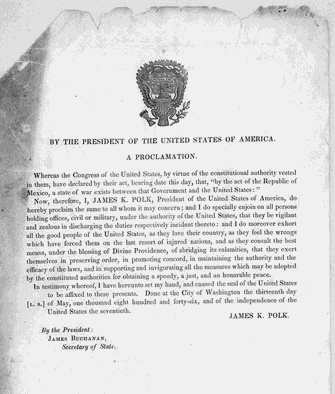
War did not await a proclamation. On May 8, Zachery Taylor was dug in at at Palo Alto (Brownsville--in memory of Jacob Brown) when attacked by 6,000 Mexican troops. In a four hour battle highlighted by the bravery of both sides, United States artillery fire broke Mexican ranks. Mexicans beat a retreat into Mexico. Mexican deaths - 600; American's killed in action - 200.
On May, 17, 1846, Taylor went on the offensive and crossed the Rio Grande into Mexico. His line of march en route to Monterrey (not to be confused with Monterey, California) resulted in numerous skirmishes with the Mexicans applying holding actions to protect Monterrey. Between September 21-24, Taylor besieged and entered the city in hand to hand battle until the Mexicans surrendered.
Mexican American History.
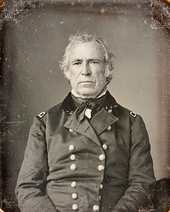 |
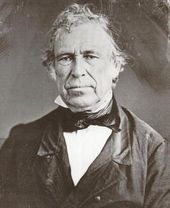 |
Mexican American History:
General Taylor serving under Winfield Scott As 12th President of the United States
Mexican American History.
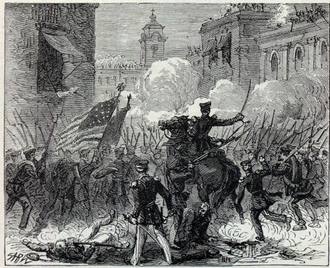
Mexican American History
Battle of Monterrey
Jean Baptist Boyot
In Washington, the Secretary of War, William M. Marcy, drew up a strategic blueprint with his generals. They concluded that simultaneous, multiple fronts would apply the necessary pressure on the Mexican army that would force its collapse.
On August 18, 1846, Colonel Stephan Kearny led 1600 Americans into New Mexico territory and captured the large town of Santa Fe. He then continued his march to California. His untrained mule corps created numerous problems and delays.
While Kearney was en route, guided by Kit Carson who was technically under the command of Major John C. Fremont, ostensibly in California to survey and locate the source of the Arkansas River. Fremont was actively fomenting rebellion against Mexican control. A small group of American Californians on June 14, commenced a revolt. They quickly seized military control with the capture of the Mexican commandant, and then declared California as the "Bear Republic". The Republic had a 25 day life when Fremont arrived with his small force and took control.
Mexican American History.

Colonel Kearny finally arrived in California, and immediately on December 6, 1846, was met with a superior, rested Mexican force and suffered a bad defeat. Kearny's troops were soon supplemented by Fremont and sailors and marines from the United States Pacific Squadron that was blockading the southern coast of California. By January 8, 1847, California was in American hands. One year later, the potential state had a sizable population. Gold was discovered. Too late for Mexican exploitation, but Mexico still resisted the Americans.
The American plan appeared stalled and Zachery Taylor was fighting a
defensive war against unyielding Mexicans. . General of the Armies, Winfield Scott,
ever resourceful, was ready with a new strategy that involved a 600
mile sea journey southward beginning in Texas. This required an amphibious
landing at Vera Cruz, and if unimpeded, a 200 mile march over rough,
mountain terrain to Mexico City. He drew, to implement his plan, troops from
Taylor leaving the latter much disturbed. This reduction of troop
strength made Taylor particularly vulnerable when Santa Ana (newly
re-elected as president), learned that the Taylor force had
been diminished. click to enlarge
Santa Ana threw 25,000 men at arms against Taylor's five thousand men on February 22, 1847. On the following day, the American defenses appeared on the verge of collapse. The Americans mounted a fierce counter attack that broke the Santa Ana offensive forcing him to retreat with a loss of 40% of his army. Taylor lost 700 men at the Battle of Buena Vista. Low on funds, Santa Ana helped himself to the treasury of the Catholic Church.
Counter Attack Mexican American History.
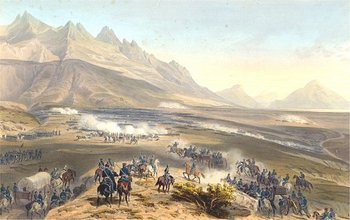
Mexican American History
Carl Nebel
After Winfield Scott made landfall, he commenced a siege of Vera Cruz (pictured below) on March 9. His staff officers, Robert E. Lee, P.G. Beauregard and George B. McClellan, would burnish their own national reputations less than 15 years later. They opposed each other in blue an gray uniforms.
Although the Mexicans were under manned and low on supplies, they held out for 20 days before surrendering. Scott had his 14,000 man army largely intact and ready to leave Vera Cruz for his march toward Mexico city.
Mexican American History.
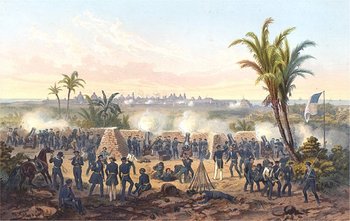
Carl Nebel
On April 18, Scott's forces were about 50 miles outside of Vera Cruz when he encountered Santa Ana"s troops defending a mountain pass that Scott would have to traverse on his march to Mexico City. The defensive position at Sierra Gordo appeared impregnable. As so often in war, a commander overlooks apparent, unassailable terrain and leaves it lightly defended while the opposing force looks for just such an advantage to flank the enemy. Captain Robert E. Lee located the Achilles Heel and Scott executed a flanking movement that broke the Mexican forces that sustained 1000 casualties and 3000 captured. The American losses were about 450. click to enlarge
Mexican American History
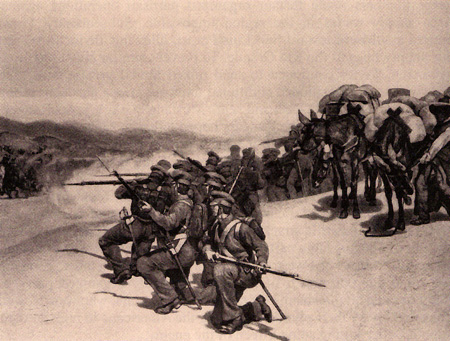
Mexican American History
Defense of Supply Train
Library of congress
Mexican rear guard actions harassed and slowed the advance of the Americans through out the hot summer months. The Americans had fought there way to Mexico City by August. Once again Americans recognized that the city's location made it almost impregnable. Americans looked for a key to entry. They found a lightly defended swamp to cross. That now placed them in excellent position and they proceeded to bombard the city.
All the combatants realized that further battle would result in unacceptable losses. On August 22, a truce was arranged to discuss peace terms. Santa Ana appointed the former president, Jose Herrera as his chief negotiator. After 10 days of talks there was no agreement on boundaries and a demand that the United States pay damages to Mexico. Polk wasted no time ordering Scott to resume the attack and to inflict heavy damages on the Mexicans.
September 12, 1847, the American cannon began to destroy entire streets. Cannon were placed to create heavy damage to the city. Lt. Ulysses S. Grant located cannon on top of a church.
Americans massed their forces to prepare a bombardment of Chapultepec Palace---a fortress in its own right. It was located on a hill over looking the city walls, and in clear sight of central Mexico City.
On September 12, in the early morning, the bombardment ceased. The defenders of the fort, about 800 hardened soldiers and 300 teen age cadets, readied for the American assault. The knew they were the last line of defense of the city. American infantry and marines rushed the wall with scaling ladders. The climb was about 14 storeys high. Mexicans, above, fired point blank at the climbers. Americans scaled the walls and hand to hand combat ensued. Nearly all of General Bravo's forces were mercilessly hacked to death. The few remaining cadets threw themselves from the wall in a mass suicide rather than submit to the Yanquis. They are now memorialized as the "Boy Heroes" ----Los Ninos Heroes.
Santa Ana had been shielded in the city and fled before capture. Now, the peace terms were again on the table. This effectively closed the war in the fall of 1847. The aftermath was diplomacy.
Mexican American History Mexican American History.
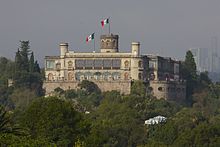 |
 |
The territorial demands made by General Scott were rejected. The peace conference dragged on until the fall. President Polk was angered with the delays and blamed Scott for the inaction. Polk insisted that all the Mexican territories were to be included and there was no room for compromise.
In the autumn, Polk sent his personal emissary, Nicholas B. Trist, to aid Scott. In the United States there were those who were demanding U.S. annex Mexico. Though this was not included as a demand in Trist's portfolio. The American negotiating team understood that there actually was no functioning government. Santa Ana had again resigned his office.
On February 2, 1848, a new appointed president, Pena y Pena, came to the table in Guadalupe Hidalgo. All of Mexico's territories north of the Rio Grande River were ceded to the United States. In a switch of policy, America agreed to pay Mexico 15 million dollars in an act of a victor's magnanimity and recognition of their national insolvency.
Mexican American History.
"Treaty of Peace, Friendship, Limits and settlements with the Republic of Mexico"
Mexican American History.
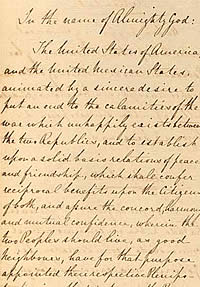
Library of Congress
Mexican American History
The cost of the war: 10,000 killed or death by disease and 100 million dollars expended. President Polk added to the war powers of the executive branch. General Taylor, a Whig, with probable sympathies for peace followed Polk as president. General Scott, who always coveted the presidency, lost a bid to Franklin Pierce.
The inability of the political parties to resolve the issue of slavery in the territories, the future states, was another issue that led to the fracture of the Union in 1861.
Mexican American History.
A prevalent New England sentiment on the Mexican American War:
Ez fer war, I call it murder
There you hev it plain an' flat
I don't want to go no furder
Than my Testyment for that.
Boston Courier
Courtesy of Don Nardo
Mexican American History
_____________________________________________________________________________________________________
Mexican American History Sources:
Library of Congress
Mathew Brady Studio
Teaching American History.org
Mexican American History References:
Mexican American History
American Military History, John Whiteclay Chambers II, Editor, Oxford Union Press, New York,New York 1999
Encyclopedia of American Military History, Spencer C. Tucker, Facts on File, New York, New York,2003.
Kane, Jopseph Nathan, Facts About the Presidents, H.W. Wilson, New York 2009.
Mancall, Peter C. American Eras, A Manly, Inc Book, Detroit 1999.
Nardo, Don, , Lucent Books, Inc. San Diego, CA 1991.
American Wars | Mexican American War | Mexican American History
